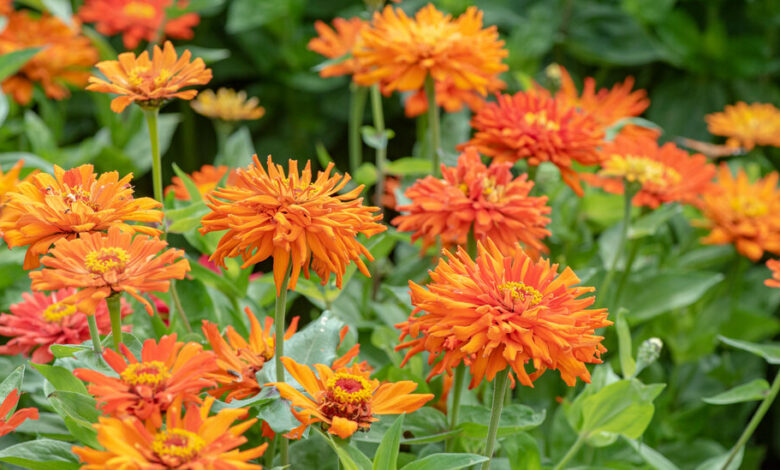It’s OK to Get Carried Away When You’re Shopping for Flower Seeds

[ad_1]
Not to put a damper on your seed-catalog bingeing — it marks the ritual start to every new garden season, after all — but Andrew Schuyler has a question: Is there a plan attached to your impulsive behavior?
Go ahead and let the catalogs’ vivid descriptions and photographs seduce you into trying something unfamiliar. Mr. Schuyler (who goes by Drew) always does.
Some of his impulse purchases of annual flowers in recent Januarys have resonated with visitors at Untermyer Gardens Conservancy, the 43-acre public landscape in Yonkers, N.Y., where he is the assistant head gardener.
They include the orange-red tassel flowers (Emilia coccinea) that call in autumn’s migrating monarch butterflies. And the four-inch-wide, deep orange zinnias (Zinnia elegans Inca) that called out to an R&B artist who was filming a music video at the garden and snagged one as an impromptu prop.
“One or two really great plants show up every year that are only in the garden because we grew them from seed,” Mr. Schuyler said. “They were not part of the plan — just something extra we tried.”
The master plan for Untermyer’s extensive display beds, borders and containers had been designed well in advance, with more than 8,000 young plants, or plugs, ordered to match. Then some irresistible oddballs ended up in a shopping cart on a winter whim.
But for each happy afterthought, Mr. Schuyler promptly took the next step: He married every impulse with an equal measure of discipline, studying up on exactly how — and when — to sow those seeds.
“I approach it the way I approach cooking,” he said, “which is to look at a ton of recipes and then find some middle ground to guide me.”
When he saw a catalog photo of purple bell vine (Rhodochiton atrosanguineum), he imagined how it would look cascading out of hanging baskets rather than climbing. Its flowers are extravagant, with an extra-long, maroon-purple clanger dangling from each fuchsia bell; its distinctive leaves are heart shaped, with toothed edges.
But the plant was unfamiliar and proved to have particular needs: Both light and warmth are required for germination, and it can sometimes take more than a month for seedlings to emerge.
Good to know, or he might have given up on it too soon.
Make a Calendar and Organize Your Packets
A favorite resource for this homework assignment is Mr. Schuyler’s tattered copy of the industry classic “Ball Culture Guide: The Encyclopedia of Seed Germination,” by Jim Nau, formerly of the Ball Seed company. Seed catalogs are another important information resource, notably Johnny’s Selected Seeds and Select Seeds. Both offer solid, detailed growing information.
Each acquisition and any secrets revealed — the ideal sowing depth and temperature requirements, for instance — make their way onto Mr. Schuyler’s spreadsheet, arranged in order of when the seeds will be sown.
Here’s how to calculate that: Subtract the number of weeks each variety requires indoors from when you plan to transplant it into the garden. The earliest possible set-out date is based on how long before or after the final frost a variety can be safely set outside, according to your research. (This online calculator can help.)
Open the cheese drawer of the Untermyer staff refrigerator, and you’ll see corresponding evidence of such planning among the packets in cold storage. Multiples are joined by rubber bands, a Post-it note affixed to each little bundle to indicate the intended start date. Cosmos, zinnias, marigolds and Mexican sunflowers (Tithonia rotundifolia), for instance, are marked to get going together on Apr. 1.
More Choices: Season-Stretching Calendula and an African Milkweed
For professional and home gardeners, starting from seed has many advantages — not the least of which is a far more extensive range of possibilities than garden centers stock as transplants in the spring.
Those who want color weeks before most popular annuals bloom don’t have to settle for any old basic solid yellow or orange calendula (Calendula officinalis) — if the local nursery even sells calendula seedlings. A seed order can deliver sophisticated peach-colored flowers like Sunset Buff, Triangle Flashback or Orange Flash, with dark centers and bicolor petals, their undersides revealing contrasting reddish or bronze tones.
Something else you won’t find at the garden center is an African milkweed that puts on a big late-season show, with masses of three-inch papery green pods covered in spiky hairs adorning stems that grow to four feet or taller. Asclepias physocarpa (or Gomphocarpus physocarpus) is a plant of many names, including Oscar milkweed, hairy balls and balloon plant, and makes for high drama in the ground or in a vase — including when it’s dried.
The Untermyer “last-minute surprises” list recently included Zinderella Peach, a zinnia whose blooms look more like a scabiosa’s. Capsicum annuum Black Pearl, a pepper that doesn’t look like a pepper, also made its way into the garden, likewise started from seed.
“‘What is this black cherry?’” Mr. Schuyler recalls visitors asking of the purple-black fruits on bushy plants with matching foliage. “Nobody knew it was a pepper until they started to turn red in September.”
It’s a purchase that he highly recommends.
Successions: Plan Now to Fill Holes Later
Growing flowers from seed also empowers the gardener to produce backup seedlings to swap in later, as early plantings tire — a moment when nurseries are no longer stocking transplants.
Don’t expect a flowering annual to carry on from spring through fall any more than you would expect a row of lettuce to, Mr. Schuyler advised. Even the longest bloomers have their limits.
“We think of something like Cosmos as all-summer blooms, but even Cosmos peters out,” he said. “Ones you sow in April are going to be done by August; ones you sow in July will take you to November. This isn’t a one-and-done situation.”
This year, there will be lots more successions to work into the seed-sowing calendar, including lettuce. Two of Mr. Schuyler’s colleagues are browsing catalogs for seed to bring to life a new section of the Untermyer landscape.
A quarter-acre formal vegetable garden and small orchard overlooking the Hudson River was prepared last year by high school interns, who will plant and tend the vegetable beds in the coming season — and perhaps even suggest some last-minute additions of their own.
Key Steps for Starting Better Seedlings
Mr. Schuyler cultivated his propagation skills as a student at the Longwood Gardens Professional Horticulture Program, in the Brandywine Valley area of Chester County, Pa. Producing thousands of plants in a large-scale greenhouse setting requires a modular system: Everything at Untermyer Gardens is produced in four-inch pots, with 15 to a flat.
Rather than seeding into trays of individual cells, each variety is first sown thickly into one of those pots. It typically grows there until the first true leaves appear, although robust growers may be ready for the next step when they still have only seed leaves, or cotyledons.
Then the sturdiest among each thicket of tiny seedlings is moved up to its own pot, a process called pricking out (see the slide show for how-to tips). At home, you could just move each into its own cell.
For those determined to grow better seedlings, Mr. Schuyler offered some advice.
Don’t start too early. “As excited as you might be in February to sow all your flower seeds, you really only need to do pansies then,” he said.
Make a calendar. Do the math, subtracting the weeks required indoors from the desired outdoor transplant date. Then organize packets by sowing date. Schedule succession-sowing dates later on, too, to fill holes with fresh transplants when early crops fade.
Invest in lights, like an LED strip light and stand from SunBlaster. Windowsills don’t support strong seedlings.
Use germinating mix labeled for seed-starting — not potting soil, which is coarser. (And never garden soil.)
Wet the medium in a garden tub before filling containers. You don’t want it to be sodden and dripping, just evenly moist. “If your germination mix isn’t fully wetted at the start,” Mr. Schuyler said, “subsequent waterings won’t fully wet it, and there will be dead spots the water never got to.”
Tamp the seed bed down before sowing into it. Mr. Schuyler uses a block of wood to form a solid, even base.
How deep should you sow? Research whether a particular seed should be covered or if it needs light for germination. “If it says it wants light, I’ll just press the seed in,” he said. “If it says cover, I’ll lightly cover.”
Sift, don’t smear. Applying an uneven covering of germination mix by hand and spreading it with your fingers risks moving seed into clumps. Use a wire colander instead to sift a layer on top.
The finishing touch: A top dressing of granite poultry grit (available at Tractor Supply Company) helps keep the soil surface clean, reducing disease.
Is heat required? Varieties that require heat to germinate should go onto an electric heat mat. But remove the seedlings promptly upon germination, or risk weakening them.
When watering, think mist, not deluge. “I had a teacher at Longwood who said that you have to keep a ‘crystalline fairy energy’ in the greenhouse, and I think that’s pretty much the best advice I’ve ever gotten,” Mr. Schuyler said. “Just keep things light; we’re not trying to pummel these seedlings. You just want to mist them.” The Solo 418 one-liter, one-hand sprayer would handle a few flats; in a bigger setting, Mr. Schuyler uses a hose-end mist nozzle, like the Dramm 510.
Margaret Roach is the creator of the website and podcast A Way to Garden, and a book of the same name.
For weekly email updates on residential real estate news, sign up here.
[ad_2]
Source link






